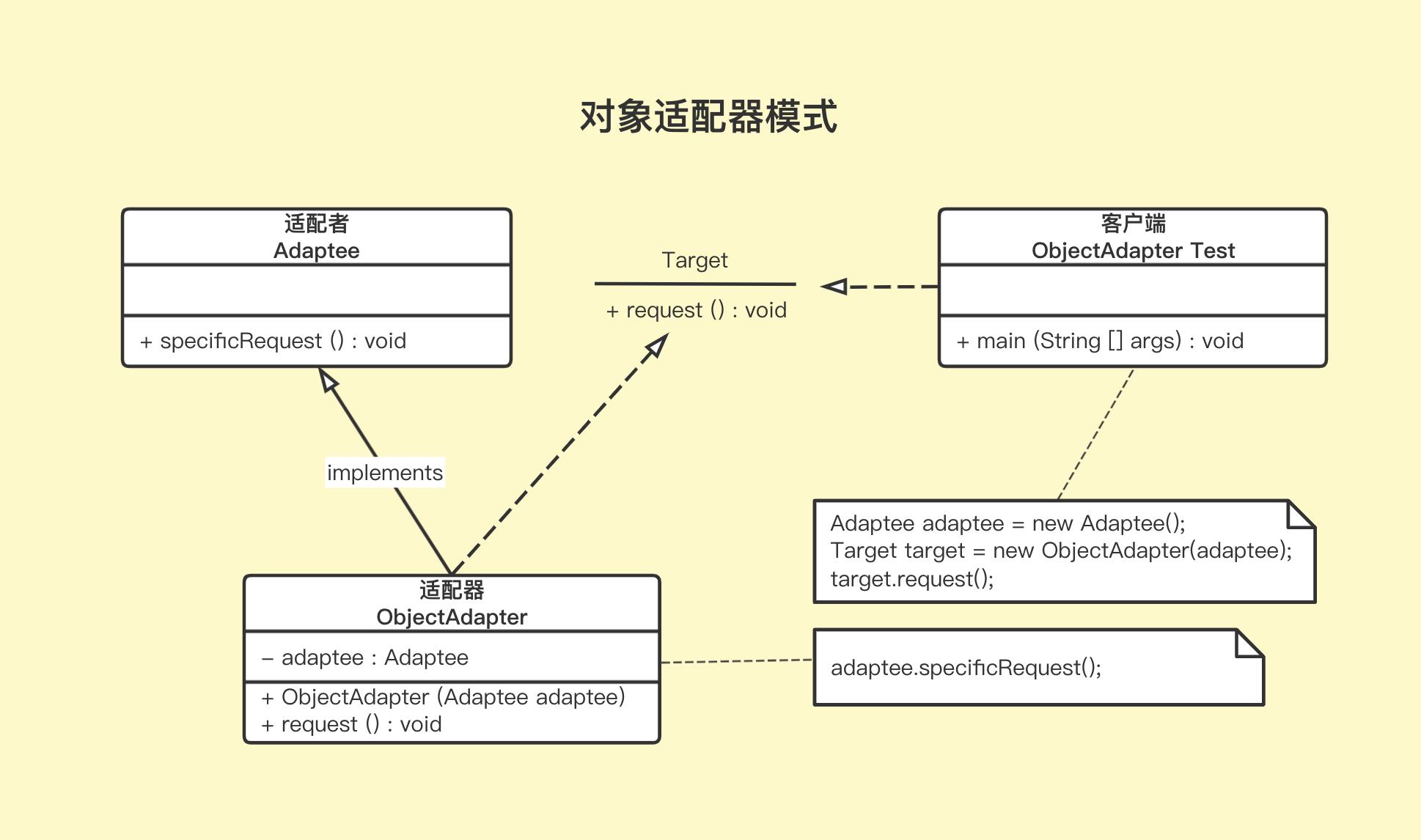设计模式之适配器模式(结构型)
Posted 思想累积
tags:
篇首语:本文由小常识网(cha138.com)小编为大家整理,主要介绍了设计模式之适配器模式(结构型)相关的知识,希望对你有一定的参考价值。
1、简介
1.1 定义
适配器模式 Adapter:将一个类的接口转换为客户端希望的另外一个接口,使原本因为接口不匹配(或者不兼容)而无法在一起工作的两个类能够在一起工作。像是 Mac 的转换头、插座、数据线等,都是适配器模式的体现
1.2 结构
适配器模式(Adapter)包含以下主要角色
- 目标(Target)接口:当前系统业务所期待的接口,可以是抽象类或接口
- 适配者(Adaptee)类:被访问和适配的现存组件中的组件接口
- 适配器(Adapter):转换器,通过继承或引用适配者的对象,把适配者接口转换为目标接口,让客户按照目标接口的格式访问适配者
1.3 优缺点
优点:
- 客户端通过适配器可以透明的调用目标接口
- 复用了现有的类,不需要修改原来的代码而重用现有的适配者类
- 将很多目标类和适配者解耦,解决了目标类和适配者类接口不一致的问题
缺点:
- 对于类适配器来讲,更换适配器的实现过程比较复杂,可能增加系统复杂性
- 用的多了会使系统代码变得凌乱
1.4 分类
适配器模式分为类结构性模式和对象结构型模式两种,类结构型模式用的较少些,并且类之间的耦合度比对象结构型模式更高一些
1.4.1 类的适配器模式(继承实现)
类适配器模式——适配器继承自己实现的类(一般多重继承)
Adapter 与 Adaptee 是继承关系
- 用一个具体的 Adapter 类和 Target 进行匹配。当我们想要一个匹配一个类以及所有它的子类时,类 Adapter 将无法胜任工作
- 使 Adapter 可以重定义 Adaptee 的部分行为
- 仅仅引入一个对象,并不需要额外的指针以简介取得 adaptee

1.4.2 对象适配器(对象组合实现)
Adapter 和 Adaptee 是委托关系
- 允许一个 Adapter 与多个 Adaptee 同时工作,Adapter 也可以一次给所有的 Adapter 添加功能
- 使用重定义 Adaptee 的行为比较困难
无论哪种适配器都是为了在不改变原有系统的基础上,提供新的接口服务

2、代码实现
2.1 类适配器
// 目标接口
public interface Target
void request();
// 适配者类
public class Adaptee
public void specificRequest()
System.out.println("适配者被调用");
// 类适配器
public Adapter extends Adaptee implements Target
@Override
public void request()
specificRequest();
// 客户端
public class ClassAdapterTest
public static void main(String[] args)
Target target = new ClassAdapter();
target.request();
// 运行结果如下:
// 适配者被调用
2.2 对象适配器
// 目标接口
public interface Target
void request();
// 适配者
public class Adaptee
void specificRequest()
System.out.println("适配者被调用了");
// 对象适配器
public class ObjectAdapter implements Target
private Adaptee adaptee;
public ObjectAdapter(Adaptee adaptee)
this.adaptee = adaptee;
@Override
public void request()
adaptee.specificRequest();
// 对象适配器测试
public class ObjectAdapterTest
public static void main(String[] args)
Adaptee adaptee = new Adaptee();
ObjectAdapter objectAdapter = new ObjectAdapter(adaptee);
objectAdapter.request();
3、应用场景
- 使用第三方提供的组件,但组件接口与自己要求的接口定义不同
- 以前开发的系统中存在满足新系统功能需求的类,但接口与新系统接口不一致
4、模式扩展
适配器模式(Adapter)可以扩展为双向适配器模式,可以把适配者接口转为目标接口,也可以把目标接口转为适配者接口,如下图所示

代码实现:
/**
* 目标接口
*/
public interface TwoWayTarget
void request();
/**
* 目标实现
*/
public class TargetRealize implements TwoWayTarget
@Override
public void request()
System.out.println("目标代码被调用");
/**
* 适配者接口
*/
public interface TwoWayAdaptee
void specificRequest();
/**
* 适配者实现
*/
public class AdapteeRealize implements TwoWayAdaptee
@Override
public void specificRequest()
System.out.println("适配者代码被调用");
/**
* 双向适配器
*/
public class TwoWayAdapter implements TwoWayAdaptee, TwoWayTarget
private TwoWayTarget target;
private TwoWayAdaptee adaptee;
public TwoWayAdapter(TwoWayAdaptee adaptee)
this.adaptee = adaptee;
public TwoWayAdapter(TwoWayTarget target)
this.target = target;
@Override
public void specificRequest()
target.request();
@Override
public void request()
adaptee.specificRequest();
/**
* 双向适配器客户端
*/
public class TwoWayAdapterTest
public static void main(String[] args)
TwoWayAdaptee adaptee = new AdapteeRealize();
TwoWayTarget target = new TwoWayAdapter(adaptee);
target.request();
System.out.println("~~~~~~~~~~~~~");
target = new TargetRealize();
adaptee = new TwoWayAdapter(target);
adaptee.specificRequest();
以上是关于设计模式之适配器模式(结构型)的主要内容,如果未能解决你的问题,请参考以下文章